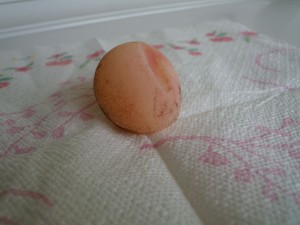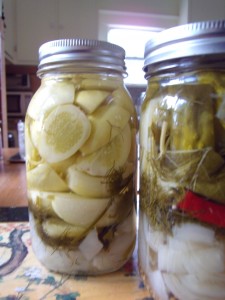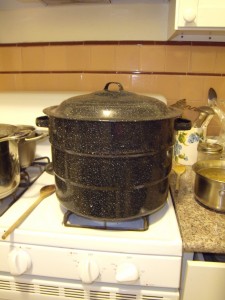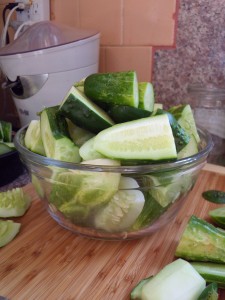The combined queenless colonies are dead. Despite reducing the hive entrance to discourage robbing, they were robbed silly by the other colonies in the neighborhood. I suspect that the queen cell we had spotted and were banking on was dead before we combined the hives. At any rate, it never hatched.

One of the previously hatched queen cells in Percy that must not have made it.

You can see evidence of robbing at the top of the frame. The robber bees chew up the wax to get to the honey, leaving it ragged looking.
I discovered this today when I dismantled the hive. I also discovered that for some reason the neighborhood bees hadn’t finished the job of robbing; there was a fair bit of capped honey above the brood comb that I whisked away to the basement freezer. There were also earwigs and small hive beetles. I found them skulking in wax crevices, and they ran from the glare of the sunlight.

A small hive beetle on a mission. Click to enlarge for a better view.
So what happened to the queens?
We don’t really know what happened to the queens in these two colonies. Percy was a good-sized swarm in early July, but its numbers started dropping quickly as the month wore on.
To be honest, I think they might have been just fine if I had fed them. We are still ironing out our beekeeping philosophy. Kelly and I had a long conversation about whether or not to feed Percy and decided that, although we have always fed swarms in the past, this did not reflect our intention to let our bees fend for themselves.
If a feral colony swarms late in the season and finds a tree cavity to move into there is no one refilling a jar of sugar syrup for them every few days. They sink or swim, and the continuation of their genetics depends on their ability to tough it out in whatever environment they find themselves. They are self-made bees.
Granted, feral colonies don’t have to contend with a couple of clumsy humans stealing their honey, either. We are manipulating our colonies and changing the course of their existence. So where do we draw the line? What is too much meddling, and what is appropriate?
If I had it to do over again, I would feed Percy. This is partly because I hate to see a colony die, but it’s also because I moved them about 14 miles from where they had swarmed. They arrived in my neighborhood relatively late in the season and with no geographical knowledge of where to forage. Maybe I’m making excuses for them, but it seems to me that this put them at a distinct, if temporary, disadvantage.
Package bees go queenless
The second queenless colony, April, started out as package bees this spring. They came from a bee breeder who supposedly takes special measures to ensure strong genetics. Specifically, she does not treat her bees and her packages contain queens bred from breeder queens that have survived at least two years. Unfortunately, the rest of the bees in the package are leftovers from almond pollination, leading me to wonder what diseases and pests they bring along with them.
This colony never boomed, though its numbers were decent through the spring and early summer. Dismantling the hive, I found no signs that April had tried to rear a new queen after the demise of their matriarch. It’s possible that we rolled the queen (killed her) during one of our summer hive inspections. This doesn’t explain, however, why the bees would not have tried to raise a new queen.

We used foundationless frames in April, and although there were some issues at first with cross- combing, the girls ultimately drew beautiful frames of wax with only the aid of glued-in craft sticks as a guide. The dark wax is brood comb, while the light-colored wax at the tops of the frames was used to store honey.

Stored pollen from April.











